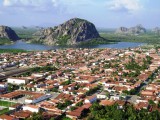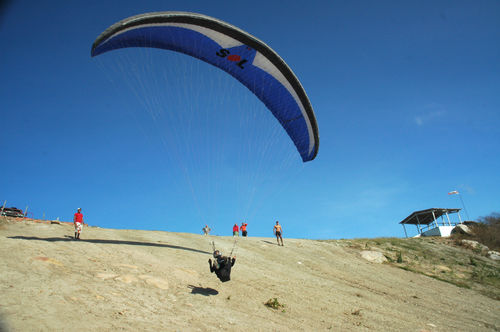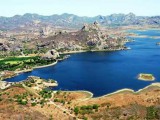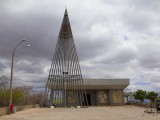Este post também está disponível em:
Português
English

Quixadá is a municipality in Ceará and is 175 km from Fortaleza, belongs to the Mesoregion of the Sertões Cearenses and the micro-region of the Sertão de Quixeramobim. It is the largest in the central hinterland, with a population of 100,000.
Quixadá is known as the university city of the central hinterland, in the year 2014 has six institutions of higher education, public and private. These include campuses of the Federal University of Ceará and State University of Ceará.
One of its most striking features of Quixadá are rock formations, the monoliths, in the most diverse formats that “break” the apparent monotony of the sertaneja landscape.
Quixadá is also known for being the land of writers such as Jáder de Carvalho and Rachel de Queiroz who, despite being born in Fortaleza, the capital of Ceará, had a very strong relationship with the city, visiting it constantly, when she stayed at her Fazenda Não Me Deixes, which she inherited from her father, Daniel de Queiroz.

Guia de turismo de Quixadá no Ceará
The most famous of the monoliths is shaped like a chicken and became known as Galinha Choca. The stone is the city’s postcard and can be seen from anywhere in the city.

Among the best known ecological trails in the region are the Boqueirão Trail (Reduto Farm), the Cabeça do Gigante Trail (Santa Fé Farm), the Barriguda Trail (Magé Farm) and the Andorinhas Trail (Junco Farm).
Although little explored, the municipality has great tourist potential, especially for ecotourism due to the beauty of its landscapes, as well as for the practice of extreme sports such as free flight (paragliding and hang-gliding), off-road, trekking, orienteering, mountaineering and abseiling.
What to do in Quixadá
Açude do Cedro
It is one of the formations – a work to combat drought designed by Dom Pedro II. Walking along the wall, the tourist sees the most curious of the stones: the “broody hen”. In addition to sparking the imagination, the monoliths offer action. Visitors can spend a whole day climbing and abseiling.
Sanctuary of Our Lady Immaculate Queen of the Hinterland
It is a Catholic temple located 12 km from the center of the city of Quixadá, in the state of Ceará. It is about 550 m above sea level, on the Morro do Urucu.
On the way is the Via Sacra, with life-size sculptures that lead the visitor to the sanctuary of Our Lady Immaculate.

Inside the Sanctuary of Our Lady Immaculate Queen of the Hinterland there are panels with images of the Virgin Mary with the name in which she is venerated in twenty-seven Latin American countries.
With a pleasant climate, it has a grotto, a restaurant (from where you have a view of the monoliths, lagoons and local vegetation), a hotel, an auditorium and a bookshop. Near the Sanctuary there are also trails for trekking and ramps for paragliding and hang-gliding.
On the way up the mountain, you can follow religious stations, with statues of 1.80 m high, depicting the Passion and Resurrection of Christ.
The sanctuary has become a pilgrimage point for faithful from Ceará and other states. Every weekend, devotees and visitors visit the place that also has a chapel for prayers, an area suitable for religious retreats and a restaurant. The months of greatest visitation, in addition to the month of February dedicated to the festivities of the Virgin Mary, there are a large number of visitors in the months of May, July and December.
Serra do Estevão
Located 12 km from Quixadá, the place is a paradise covered with vegetation at 400 meters of altitude. Once there, be sure to visit the Chapel of Nossa Senhora da Conceição, built in 1903 in Baroque style. The mountain is also home to another tourist attraction in the region, the Monastery of the Holy Cross, also built in 1903, in colonial style.
Pedra da Galinha Choca
The most famous monolith in the city. According to legend, it is the mother of all the other stones and has already changed its location.
Pedra do Cruzeiro
Located in the city center and the Talking Stone, or Faladeira – so known for reproducing the voices emitted at its foot.
Crafts of the Region
In weaving, braiding, leather and lace.
Cedro Dam
The seventh largest water reservoir in Ceará. It has places for bathing, boat fishing and water sports.
Banabuiú
A little over 50 km away, in the neighboring municipality of Banabuiú, the radical attraction is due to the waters.
The permanent flow of the Banabuiú reservoir that supplies the city forms the bridal veil: an opportunity for tourists who want to challenge the rapids of the river. Those who are already experienced can take the kayak right up to the artificial waterfall.
Regional cuisine
Lamb for the main course and, for dessert, a sertanejo version of petit gateau. “In the sertão, coconut was always used. And here we have developed an oven-baked coconut and serve it in the quenga itself. It goes hot and goes with ice cream, which we call the petit gateau of the matuto”.
Biography of Rachel de Queiroz
Rachel de Queiroz (1910-2003) was a Brazilian writer. The first woman to enter the Brazilian Academy of Letters, elected to chair No. 5 in 1977. She was also a journalist, novelist, chronicler, translator and theater writer. She was a member of the Effective Members of the Cearense Academy of Letters.
Her first novel “O Quinze” won the Graça Aranha Foundation prize. “Memorial de Maria Moura” was made into a television miniseries and shown in several countries.
Rachel de Queiroz (1910-2003) was born in Fortaleza, capital of Ceará, on November 17, 1910. Daughter of Daniel de Queiroz Lima and Clotilde Franklin de Queiroz, she was descended on her mother’s side from the family of José de Alencar.
In 1917, she moved to Rio de Janeiro with her family, who were trying to escape the drought that had hit the region since 1915. The novelist would later use the theme to write her first book “O Quinze”. Shortly afterwards, they moved to Belém do Pará, where they spent two years.
Back in Fortaleza, she entered the Colégio Imaculada Conceição, graduating as a teacher in 1925. She made her debut in journalism in 1927, in the newspaper “O Ceará”, under the pseudonym Rita de Queluz, publishing a letter ironizing the Queen of Students contest.
At the end of 1930, when she was only twenty years old, she made a name for herself in the literary life of the country with the publication of the novel “O Quinze”, a work of social background, deeply realistic in its dramatic exposition of the secular struggle of a people against misery and drought. The book was published in only one thousand copies and already showed the characteristics that would mark his entire work. His success came with the Graça Aranha Foundation Prize in 1931.
In 1932, he published a new novel, entitled “João Miguel”. In 1937, he returned with “Caminho de Pedras”. Two years later, he won the prize of the Felipe d’Oliveira Society, with the novel “As Três Marias”. In Rio, where she lived since 1939, she collaborated in “Diário de Notícias”, in the magazine “O Cruzeiro” and in “O Jornal”.
Rachel de Queiroz published more than two thousand chronicles, which resulted in the edition of the books: “A Donzela e a Moura Torta”, “100 Crônicas Escolhidas”, “O Brasileiro Perplexo”, “O Caçador de Tatu” and “Cenas Brasileiras” (Brazilian Scenes)
In 1950, he published in pamphlets, in the magazine O Cruzeiro, the novel “O Galo de Ouro”. He has two plays, “Lampião”, written in 1953, and “A Beata Maria do Egito”, from 1958, awarded the theater prize of the National Book Institute. In the field of children’s literature, he wrote the book “O Menino Mágico”, at the request of Lúcia Benedetti. The book, however, came from the stories she made up for her grandchildren.
Rachel de Queiroz translated more than forty works into Portuguese. The President of the Republic, Jânio Quadros, invited her to take up the post of Minister of Education, which was refused. At the time, justifying her decision, she reportedly said: “I am only a journalist and I would like to remain only a journalist.”
She was a member of the State Council of Culture of Ceará. She attended the 21st Session of the UN General Assembly in 1966, where she served as a delegate from Brazil, working especially in the Commission on Human Rights.
She was a member of the Federal Council of Culture from its foundation in 1967 until its extinction in 1989. She was the first woman to join the Brazilian Academy of Letters, occupying chair No. 5 on August 4, 1977. She was a member of the Effective Members of the Cearense Academy of Letters. She was an honorary member of the Sobralense Academy of Studies and Letters and the Municipalist Academy of the State of Ceará.
In 1985, the nursery school “Casa de Rachel de Queiroz” was inaugurated in Ramat-Gau, Tel Aviv (Israel), being Rachel de Queiroz, the only Brazilian writer to have this honor in that country. She collaborated weekly in the newspaper O Povo, of Fortaleza and since 1988, she started weekly collaboration in the newspaper O Estado de São Paulo and in the Diário de Pernambuco.
Rachel de Queiroz died at her home in Rio de Janeiro of a heart attack on November 4, 2003.
Works of Rachel de Queiroz
O Quinze, 1930
João Miguel, 1932
Caminho de Pedras, 1937
As Três Marias, 1939
A Donzela e a Moura Torta, 1948
O Galo de Ouro, 1950, folhetins na revista O Cruzeiro
Lampião, 1953
A Beata Maria do Egito, 1958
100 Crônicas escolhidas, 1958
O Brasileiro Perplexo, 1964
O Caçador de Tatu, 1967
O Menino Mágico, 1969
Dora Doralina, 1975
As Menininhas e Outras Crônicas, 1976
O Jogador de Sinuca e Mais Historinhas, 1980
Cafute e Pena-de-Prata, 1986
Memorial de Maria Moura, 1992
Nosso Ceará, 1997
Tantos Anos, 1998
Três Romances, 1948
Quatro Romances, 1960
Guia de Turismo e Viagem de Quixadá no Ceará



















